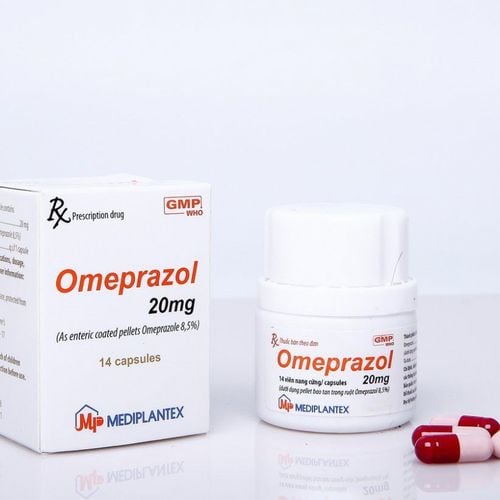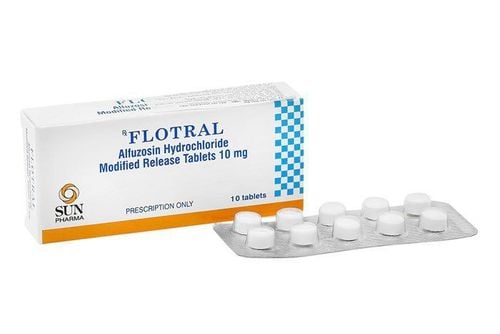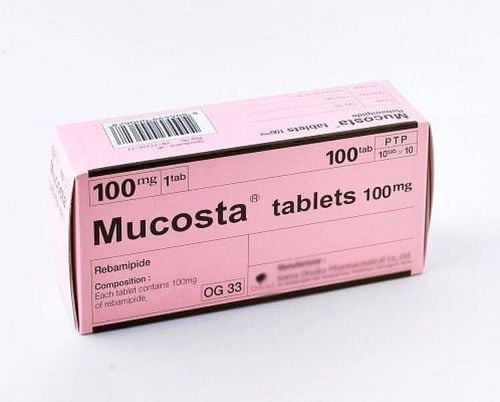This is an automatically translated article.
The main ingredient of Suprazole is Pantoprazole Sodium Sesquihydrate, which belongs to a class of drugs called Proton Pump Inhibitors (PPIs). Suprazole is commonly used in the treatment and prevention of peptic ulcers, gastroesophageal reflux disease (GERD), H. pylori infection,... Learn basic information about ingredients. The use, dosage and side effects of Suprazole will help patients improve the effectiveness of treatment.1. What is Suprazole?
Suprazole is made in the form of enteric coated tablets, with the main ingredients including:
Active ingredient: Pantoprazole (in the form of Pantoprazole Sodium Sesquihydrate) content 40mg. Excipients: Just enough for 1 tablet. Mechanism of action:
Pantoprazole Sodium Sesquihydrate is a Benzimidazole derivative that has a selective proton pump inhibitory effect, so this compound is also a proton pump inhibitor (PPI). The mechanism of action of Pantoprazole Sodium Sesquihydrate is to prevent the final step of gastric acid secretion through the formation of a covalent bond at the 2 sites of the H+, K+-ATPase system on the parietal cell surface of stomach. This effect of pantoprazole is dose-related and results in inhibition of basal gastric acid secretion and also when stimulated by any other agent. Pantoprazole's binding to H+, K+, and -ATPase causes an antisecretory effect lasting more than 24 hours.
2. Indications of the drug Suprazole
Suprazole is indicated for treatment in the following cases:
Active benign gastric - duodenal ulcer. Used in combination with Amoxicillin and Clarithromycin in the treatment of Helicobacter pylori infection. Symptomatic treatment of gastroesophageal reflux disease (GERD). Zollinger-Ellison syndrome. Prophylaxis of gastric and duodenal ulcers caused by the use of non-steroidal anti-inflammatory drugs (NSAIDs).
3. Contraindications of Suprazole
Hypersensitivity to any ingredient in Suprazole. History of allergy to medicines containing Pantoprazole Sodium Sesquihydrate. Hypersensitivity to other drugs of the gastric proton pump inhibitor (PPI) class. Pregnant or lactating women.
4. Dosage and usage of Suprazole
Note: Take Suprazole in the morning and 30-60 minutes before meals.
Dosage:
Adults and children ≥ 12 years old: Active benign gastric ulcer: Take 1 tablet (40mg)/time in the morning. Duration of treatment is from 4 to 8 weeks. Active benign duodenal ulcer: Take 1 tablet (40mg)/time in the morning. Duration of treatment is 2-4 weeks. Symptomatic treatment of gastroesophageal reflux disease (GERD): Take 1 tablet (40mg) once daily for 4 to 8 weeks. Zollinger - Ellison syndrome: Initial dose of 2 tablets (80mg) / time per day, then can be increased to 3 tablets (120 mg) / time x 2 times / day. In the elderly, the maximum daily dose is 40 mg. Treatment of H. Pylori infection: Use the regimen of Pantoprazole Sodium (Suprazole) orally 1 tablet (40 mg)/time x 2 times/day + Amoxicillin 1 g or Metronidazole 400 mg x 2 times/day + Clarithromycin 500mg x 2 times/ days, treatment for 7 days. Do not change the dose of Suprazole in the H.pylori eradication regimen in elderly patients or with impaired liver and kidney function. Children < 12 years: The use of Suprazole is not recommended because clinical safety has not been guaranteed.
5. Precautions when using Suprazole
Treatment with Suprazole with high dose or prolonged, can cause side effects such as:
Common
Systemic symptoms: Dizziness, dizziness, headache, fatigue. Skin and soft tissue: Skin rash, urticaria. Gastrointestinal disorders: Dry mouth, vomiting, nausea, abdominal pain, flatulence, constipation or diarrhea. Musculoskeletal symptoms: Muscle pain, joint pain, stiffness. Uncommon
Systemic symptoms: Body weakness, dizziness, lightheadedness, insomnia. Skin and soft tissue: Itching. Liver function: Increased liver enzymes. Rare
Systemic symptoms: Profuse sweating, malaise, peripheral edema, anaphylaxis. Skin and soft tissue: maculopapular rash, alopecia, exfoliative dermatitis, acne, angioedema, erythema multiforme. Digestive disorders: stomatitis, belching, heartburn... Should stop taking Suprazole when detecting the above symptoms or any other abnormal signs, and at the same time notify the treating doctor about the use. Suprazole and immediately go to the nearest medical facility for timely treatment.
Note the use of Suprazole in the following subjects:
Before using Suprazole, it is necessary to rule out malignancy in the gastrointestinal tract such as stomach cancer, because Suprazole can mask symptoms or slow down symptoms. in cancer diagnosis. Suprazole should be used with caution in patients with severe hepatic impairment, cirrhosis, renal failure and the elderly. Pregnancy: According to the US Food and Drug Administration (FDA) there is no evidence of safety for the use of Suprazole in pregnant women. Therefore, Suprazole is contraindicated in women who intend to or are pregnant. Lactation: There are currently no data indicating whether the active ingredient Pantoprazole Sodium Sesquihydrate contained in Suprazole can be excreted in human milk. Therefore, to ensure the safety of nursing infants, the use of Suprazole is contraindicated in this population. Drivers or machine operators may experience side effects such as dizziness, lightheadedness, dizziness, insomnia, etc. while working. Therefore, avoid using Suprazole before and during work.
6. Suprazole drug interactions
Interactions with other drugs:
Suprazole reduces the absorption of drugs with antifungal effects such as Ketoconazole, Posaconazole or Itraconazole. Avoid using Suprazole concomitantly with drugs such as Erlotinib, Posaconazole, Delavirdin, Nelfinavir. Suprazole reduces the concentration and effect of: Atanazavir. Clopidogrel. Dabigatran . Etexilate. Dasatinib . Erlotinib. Indinavir. Iron salts. Mesalamine. Mycophenolate. Nelfinavir. Suprazole increases the concentration and effect of: CYP2C19, CYP2C8 substrates. Methotrexate. Saquinavir. Voriconazole. Above is an overview of ingredients, indications, contraindications, dosage and notes when using Suprazole. In order to bring the most effective treatment for themselves and their families, patients should carefully read the instructions for use of Suprazole, and consult with the treating doctor or pharmacist before deciding to use it. .













